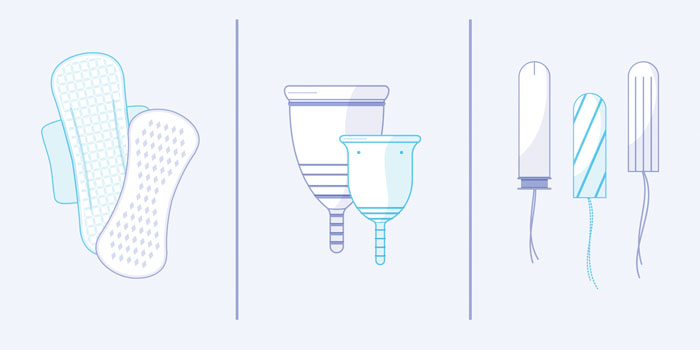In an effort to start 2020 in the most efficient way possible, it is important to discuss sustainability and waste. It is also vital to ensure that we are leading the healthiest lives possible. There is one area in which there could be a huge opportunity for improvement on both; period products. According to National Geographic, a single menstruator will use somewhere between 5 and 15 thousand pads and tampons in their lifetime.The issue? First, commercial period products are laden with chemicals that cause side effects to the consumer. Second, the products are packaged in such a way that the majority of it ends up in landfills at best and bodies of water at worst, around the world. With the population becoming more concerned with both climate change and personal wellness, it is almost astonishing that we let these products slip under the radar for so long.
The first time I heard that pads and tampons contain chemicals, I was in seventh grade. E-mail in the early 2000s was a strange place. Filled with nonsensical chain mail and spam messages. As any pre-teen, I read and quickly disregarded the email thinking it was a scare tactic. Which in hindsight was the best decision because the author’s hypothesis at that time was that period products contained asbestos. Also, even if I wanted to make a change to avoid the chemicals, there were zero accessible alternatives. Around the end of 2014, I began noticing the resurgence of the sanitary product discussion. Legally, brands like Kotex, Always, and Tampax are not required to disclose what chemicals they use to create their products because it is categorized as a medical necessity. Based on the study found on the Environmental Health News website, “Exposure to volatile organic compounds (VOCs) and phthalates increase the risk of brain impairment, asthma, disabilities, certain cancers, and the proper functioning of the reproductive system. Researchers found VOCs methylene chloride in two brands of sanitary pads; toluene in nine; and xylene in all 11 brands tested across Europe, Asia, and North America. For phthalates, the researchers found two types of the chemical in all 11 brands of sanitary pads tested.”
The more disgusting result of it all is that these products come in direct contact with one of the most permeable areas of the body, as it is covered with mucous membranes. This means that any chemicals coming into contact get directly absorbed into the bloodstream. Huffington Post mentions that this can be more dangerous than even ingesting the same chemicals. This is because at least through ingestion, the acids and enzymes of the stomach can offset the toxicity. Although these scenarios are purely anecdotal, many people, myself included, have noticed periods becoming shorter upon ditching the big box sanitary brands. Some people even experience less cramping. Some of the dyes and fragrances can cause immediate irritations and make some users more susceptible to infection. It also runs the risk of upsetting the body’s natural pH balance.
The second issue that surrounds period products is waste. Disposable pads are usually folded into a plastic wrapper, with another plastic cover for the adhesive, and packaged in more plastic. While this is a vast improvement from the days of having to wear belts to keep the pads in place, it does create a lot of pieces that contribute to pollution. Tampons can be much worse. A box of tampons contains individually wrapped products, each enclosed inside a plastic applicator. None of which are recyclable. O.B. is one brand that is applicator free but still has plastic wrapping. The switch to plastic was understandable from a comfort standpoint. Tampons used to have cardboard applicators which were at least biodegradable but could become messy. Now, if roughly half of the world has a period and they use 5 to 15 thousand menstrual products, can you imagine where all that extra plastic that cannot biodegrade or be recycled ends up? Even worse, picture how much avoidable waste is accumulated across 3.5 billion people. While we definitely don’t need to return to the barbaric practices of using scrap fabric and prayer, the amount of packaging used today is completely excessive.
So what are the alternatives? The most sustainable is the reusable menstrual cup. One cup costs around 40 dollars and can last around 10 years or more with proper care. The most popular brand is the Diva Cup and it can be found in most drugstores as of late. The menstrual cup collects instead of absorbs blood, thus lowering the risk of Toxic Shock Syndrome. It is also composed of non-toxic silicone. While there is a learning curve from traditional products, a lot of people are becoming more accepting of reusable products. There are also disposable cups that are made of similar materials. Unfortunately, these may not be an option for some people with severe PCOS or endometriosis. Another option is THINX. Founded in 2011, THINX has created absorbable, leak-resistant underwear that can be used instead of pads and tampons. Upon reviewing their website, they have options that can even cater to heavier cycles.
These next two alternatives won’t do much for sustainability other than the potential to be biodegradable, but they do resolve the chemical problem. Lola and Seventh Generation both make organic cotton period products sans chemical ingredients. Lola is a subscription service that gives the consumer options to mix and match to meet their needs, but there is also the potential for more waste in the shipping process. One interesting thing about Seventh Generation’s tampons is that they use a plant-based, biodegradable applicator! The only downside is that cotton pads, while having the same absorbency capabilities as traditional products, often lack moisture-wicking technology which means discomfort. Recently, Proctor and Gamble released cotton versions of their Tampax and Always brands. In typical business fashion, waiting to do the right thing only once it impacts the bottom line. Eventually, I am hoping that we reach a point where period products become more heavily regulated. Until that day comes, at least we have alternatives.

Sources
- National Geographic: https://www.nationalgeographic.com/environment/2019/09/how-tampons-pads-became-unsustainable-story-of-plastic/
- Environmental Health News: https://www.ehn.org/diapers-and-menstrual-pads-chemicals-2627099478.html
- Huffington Post: https://www.huffpost.com/entry/feminine-hygiene-products_b_3359581


















Add comment